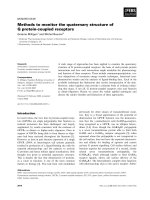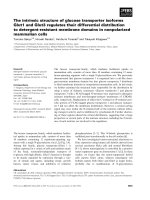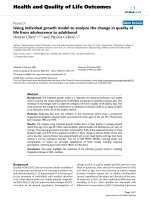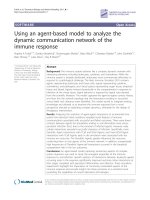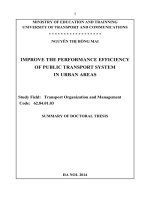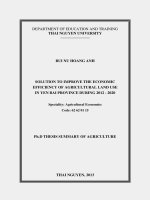To analyze the cost structure of different cropping system in indore (M. P.) India
Bạn đang xem bản rút gọn của tài liệu. Xem và tải ngay bản đầy đủ của tài liệu tại đây (251.2 KB, 10 trang )
Int.J.Curr.Microbiol.App.Sci (2018) 7(7): 3089-3098
International Journal of Current Microbiology and Applied Sciences
ISSN: 2319-7706 Volume 7 Number 07 (2018)
Journal homepage:
Original Research Article
/>
To Analyze the Cost Structure of Different Cropping System in
Indore (M. P.) India
Veena Rathore1, Harkesh Kumar Balai1* and S.K. Jain2
1
2
College of Agriculture, Indore (COA), India
Agricultural Economics & Farm Management, COA, Indore, India
*Corresponding author
ABSTRACT
Keywords
Crpping system, Cost
structure, Small
farmers,
Medium farmers,
Large farmers
Article Info
Accepted:
24 June 2018
Available Online:
10 July 2018
It is revealed that the average Cost C3 of soybean cultivation was found to be Rs.37674 per
hectare. Cost C3 was found to nominally decrease with increase size of holding due to
economic of size of holding in input utilization. The average Cost C3 of wheat cultivation
was found to be Rs.37739 per hectare. Cost C3 was found to nominally increase with
increase in size of holding it was due to higher use of purchased inputs by large size of
holding. The average Cost C3 of gram cultivation was found to be Rs.36623 per hectare.
Cost C3 was found to nominally increase with increase in size of holding it was due to
higher use of yield attributing inputs by large size of holding. In nut shell, on the basis of
data analysis on cost of cultivation of different cropping system, it can be concluded that
the overall cost of cultivation on per hectare basis of the soybean-wheat cropping system
was found to be higher. Cost C3 incurred in soybean-wheat cropping system was found to
be Rs.75413 per hectare. On the other hand, the cost C 3 incurred in soybean-gram cropping
system was found to be Rs.74297 per hectare. It shows that Cost C 3 was higher Rs.1116
per hectare in soybean-wheat cultivation over to soybean-gram cultivation.
have built mechanism of risk bearing against
environmental hazards.
Introduction
Cropping system is an important component
of a farming system. It represents cropping
patterns used in a farm and their interaction
with farm resources, other farm enterprises
and availab0le technology which determine
their makeup. Cropping system specially
intercropping and mixed cropping are
receiving greater emphasis in Indian
agriculture now, because stabilized yield
advantage, especially under adverse weather
condition, mixed and intercropping systems
Proper and well adopted cropping system
increase supply of balanced food, feed and
cash needs of marginal farmers, without extra
expense. Experimental evidences have also
proved that yield stability and monetary return
is greater with intercropping and mixed
cropping than single crop.
The Recently, huge gap between existing
cropping systems and improved cropping
3089
Int.J.Curr.Microbiol.App.Sci (2018) 7(7): 3089-3098
systems, improved cropping systems are
capable to increase the farmers land use
efficiency, productivity and economic return
with respect to farmers land use efficiency;
productivity and economic return in respect to
existing cropping systems. So this study was
chosen for calculating economies of
production of different cropping systems. The
specific objectives of study were as below:
Materials and Methods
Study area
Indore district, a progressive agricultural area,
was selected for present study due to higher
changing cropping system. In Indore district
Depalpur block was selected purposively for
the study as more cropping pattern appear in
this block.
Sampling procedure
Multi stage sampling technique was used for
drawing a sample for the present study. In the
first stage, the villages were selected for study.
At the second stage of sampling, the farmers
were selected for data collection as
respondents of study.
Selection of villages
A list of all the villages in the selected block
where cropping systems were implemented
was prepared with the help of Department of
Agriculture Indore. From this list 5 villages
were selected randomly.
Cost concepts
The cost of cultivation classified as
recommended by, “Special expert committee
on cost estimates, GOI, New Delhi”, was used
in this study. The cost concepts are given
below:
Cost A1: It includes: Value of hired human labour,
Value of hired and owned bullock
labour, Value of hired and owned
machinery labour,
Value of owned and purchased seed,
Value of fertilizers, manures and
chemical,
Value of insecticide and pesticides,
Expenditure on irrigation,
Land revenue and taxes,
Interest paid on crop loan if taken,
Depreciation on farm assets excluding
land,
Interest on working capital,
Miscellaneous expenses.
Cost A2: It includesCost A1 + rent paid for leased in land
Cost B1: It includesCost A2 + interest on value of owned
fixed capital assets. (Excluding land)
Cost B2: It includesCost B1 + rental value of owned land
Cost C1: It includesCost B1+ imputed value of family
labour
Selection of respondents
List of farmers of the selected villages was
prepared. In the third stage of selection 70
farmers were selected randomly by
proportional allocation of 3 categories i.e.
small (less than 2 ha), medium (2 to 4 ha.) and
large (more than 4 ha.). Thus 70 farmers was
the sample of present study (Table 1).
Cost C2: It includesCost B2 +imputed value of family
labour
Cost C3: Cost C2 + 10 percent of cost C2 to
account for managerial input of the
farmer.
3090
Int.J.Curr.Microbiol.App.Sci (2018) 7(7): 3089-3098
Evaluation of farm inputs
Interest on working capital
Methods followed in evaluating different farm
input for the present study are described in the
following paragraphs.
It was worked out @ 12.50 percent for half of
the duration of the crop.
Interest on fixed capital
Hired human labour
The farmers normally engage permanent farm
labour on the basis of yearly wages and casual
labour on daily wage basis for performing
farm operations.
The casual labour was evaluated on the basis
of actual wages prevailed in the locality.
The wages of male and female labour included
payment given both in cash or kind. The value
of kind components given to the labour was
calculated at their prevailing market prices.
Interest was charged @ 10 percent per annum
on the value of implements, machineries, farm
building, and irrigation structure and draft
animals. It excludes interest on land input,
because rental value of owned land is
calculated separately.
Rental value of owned land
It was calculated on the basis of 25 percent
(1/4) of the gross income or prevalent rate in
the area for the same.
Return concepts
Family labour
Value of farm produce
The family labour cost was evaluated at the
rate of prevailing wage rates in the locality for
casual hired labour at various stages of
operations.
Bullock and machinery labour
Estimation of bullock and machine labour
charges on actual wages prevailed in the
locality were considered.
For estimation of depreciation, interest on
working capital, interest on fixed capital and
rental value of owned land, following standard
norms were used.
Depreciation on farm assets
The straight-line method was used for
calculating rate of depreciation @ 10 per cent
of assets value excluding land on per unit area
basis.
This included the value of main product and
the byproduct of the crop. The harvest price of
the crop was considered for calculating the
value of main produce. The value of by
product was calculated at the prevailing price
in the locality.
Profitability
For the estimation of profitability from
cultivation of crops, the following profit
efficiency measures were used in this study:
Gross income: It is defined as: total value of
main product +by product.
Net farm income: It is defined as: gross
income – cost „C3‟
Family labour income: it is defined as: gross
income- cost „B2‟
Farm business income: It is the gross value
of output at farm harvest prices (Main product
+by product) – cost „A1‟
3091
Int.J.Curr.Microbiol.App.Sci (2018) 7(7): 3089-3098
which is the actual farm investment made by
farmers is more important in analysis of cost
of cultivation. Cost A2 was not considered in
the study because farmers cultivated their own
land.
B.C. ratio:
Results and Discussion
Cost of cultivation of crops per hectare of
existing cropping systems
A study on economics of cultivation of
different cropping system prevailing in area is
pertinent to find out their profitability in order
to choose best alternative resources,
cultivation practices and scale of production
etc. Secondly, it gives an estimate of the
amount, the farmers would require for
cultivating as per size of crop area with
different level of technological adoption. It is
a well known fact that profitability of crop
production depends upon the cost of
production, yield per unit of area and their
relative market prices. Hence, to determine the
profitability from prevailing cropping system,
the cost of cultivation on cost concept basis of
crops was determined.
Soybean
The detail of cost of cultivation of soybean
according to different size group has been
presented in Table 2.
The total cost estimates i.e. cost C1, C2 and C3
based on the imputed values of family labour
would give an unrealistic and even misleading
picture of costs. It is attributed to the fact that
farmers try to minimize only out of pocket
expenses of cultivation and that by and large,
they make maximum use of resources they
own, but it is also not justifiable to take into
account only paid out costs. To determine the
cost structure cost C1, C2 and C3 were also
analyzed in the present study.
It is revealed that the average Cost C3 of
soybean cultivation was found to be Rs.37674
per hectare. Cost C3 was found to nominal by
decrease with increase in size of holding due
to economic of size of holding in input
utilization Similar finding were reported by
Pandey et al., (2009). The highest Cost C3 in
soybean cultivation was found to be Rs.37992
per hectare in small size of holding followed
by Rs.37805 per hectare in medium size of
holding and Rs.37226 per hectare in large size
of holding respectively.
Wheat
On the basis of different cost concepts, the
cost of cultivation of soybean under prevailing
cropping system per hectare on sample
holding determined that on an average the cost
of soybean (Cost A1, operational cost) was
found to Rs.18792 per hectare. The highest
Cost A1 of soybean cultivation was found to
be Rs.19294 per hectare in large size of
holding followed by Rs.18781 per hectare in
medium size of holding and Rs.18300 per
hectare in small size of holding. This indicated
that cost A1 increased with increase in size of
holding. Similar finding were reported by
Ahmed and Tanveer (2006). The cost A1
The detail of cost of cultivation of wheat
according to different size group has been
presented in Table 3.
On the basis of different cost concepts, the
cost of cultivation of wheat under prevailing
cropping system per hectare on sample
holding determined that on an average the cost
of wheat (Cost A1, operational cost) was found
to be Rs.19851 per hectare. The highest Cost
A1 of wheat cultivation was found to be
Rs.21309 per hectare in large size of holding
followed by Rs.19734 per hectare in medium
3092
Int.J.Curr.Microbiol.App.Sci (2018) 7(7): 3089-3098
size of holding and Rs.18509 per hectare in
small size of holding. It was found that the
cost A1 increase with increase in size of
holding. Similar finding were reported by
Ahmed and Tanveer (2006).
in gram cultivation was found to be Rs.38118
per hectare in large size of holding followed
by Rs.37349 per hectare in medium size of
holding and Rs.34403 per hectare in small size
of holding respectively.
It is revealed that the average Cost C3 of
wheat cultivation was found to be Rs.37739
per hectare. Cost C3 was found to nominal by
increase with increase in size of holding due to
higher use of purchased inputs by large size of
holding Similar finding were reported by
Pandey et al., (2009). The highest Cost C3 in
wheat cultivation was found to be Rs.39002
per hectare in large size of holding followed
by Rs.37313 per hectare in medium size of
holding and Rs.36902 per hectare in small size
of holding respectively.
Cost of cultivation of different cropping
system
Gram
The detail of cost of cultivation of gram
according to different size group has been
presented in Table 4.
On the basis of different cost concepts, the
cost of cultivation of gram under prevailing
cropping system per hectare on sample
holding determined that on an average the cost
of gram (Cost A1, operational cost) was found
to be Rs.18702 per hectare. The highest Cost
A1 of gram cultivation was found to be
Rs.21104 per hectare in large size of holding
followed by Rs.19566 per hectare in medium
size of holding and Rs.15437 per hectare in
small size of holding. It was found that the
cost A1 increase with increase in size of
holding Similar finding were reported by
Biradar and Rajkumar (2007).
It is revealed that the average Cost C3 of gram
cultivation was found to be Rs.36623 per
hectare. Cost C3 was found to nominal by
increase with increase in size of holding due to
higher use of yield attributing inputs by large
size of holding Similar finding were reported
by Pandey et al., (2009). The highest Cost C3
The detail cost as per cost concepts of
different cropping systems has been presented
in Table 5.
As already discussed, the main cropping
systems of the area are: soybean-wheat and
soybean-gram. The cost of cultivation of
different cropping system on per hectare basis
was found to vary depending upon the cost
components and different combination for
cropping systems.
Data shows that cost A1 which may be treated
as operation cost is important for economist
and farmers also because it is determined as
paid out cost from pocket. The operational
cost i.e. cost A1 incurred in soybean-wheat
cropping system was found to be Rs.38643 per
hectare. On the other hand, the cost A1
incurred in soybean-gram cropping system
was found to be Rs.37494 per hectare. It
shows that Cost A1 was higher Rs.1149 per
hectare in soybean-wheat cultivation over to
soybean-gram cultivation. Similar finding
were reported by Chauhan (2008).
It is noted that the operational cost incurred in
seed + seed treatment and plant protection
method in soybean-gram cropping system was
found to be higher than soybean-wheat
cropping system. The excess of cost incurred
in seed and seed treatment (Rs.1471 /ha.) in
soybean-gram cropping system might be due
to higher market price of gram in comparison
to wheat. Similarly the expenditure on plant
protection measure in gram crop was due to
higher damage of crop due to insect.
3093
Int.J.Curr.Microbiol.App.Sci (2018) 7(7): 3089-3098
Table.1 Allocation of farmers under study (Number)
S.No.
Size group
Total number of farmers
Total selected farmers (n)
1.
Small farmers
100
20
2.
Medium farmers
160
32
3.
Large farmers
90
18
4.
Total
350
70
Table.2 Cost of cultivation of soybean per hectare of existing cropping systems according to
their size group (Rs/ha)
S.No.
Cost practices
Size group (Soybean)
Small
Medium
Large
Average
1.
Hired human labour
2600
2800
4000
3133
2.
Bullock labour
1050
1750
1050
1283
3.
Machine power
4400
3850
3850
4033
4.
Seed + treatment
4301
4547
4589
4479
5.
Manure + Fertilizer
1354
1708
1819
1627
6.
Plant protection
1684
1638
1648
1657
7.
Irrigation charges
0
0
0
0
8.
Other costs
152
189
392
244
9.
Interest on working capital
324
343
361
343
10.
Depreciation
2382
1870
1477
1910
11.
Land revenue
53
85
107
82
Cost-A1
18300
18781
19294
18792
Interest on fixed capital
238
187
148
191
Cost-B1
18538
18968
19442
18983
Rental value of land
5000
5000
5000
5000
Cost-B2
23538
23968
24442
23983
Imputed value of family labour
11000
10400
9400
10267
Cost-C1
29538
29368
28842
29249
Cost-C2
34538
34368
33842
34249
Cost-C3
37992
37805
37226
37674
12.
13.
14.
3094
Int.J.Curr.Microbiol.App.Sci (2018) 7(7): 3089-3098
Table.3 Cost of cultivation of wheat per hectare of existing cropping systems according to their
size group (Rs/ha)
S.No.
Cost practices
Size group (Wheat)
Small
Medium
Large
Average
1.
Hired human labour
3400
4400
4800
4200
2.
Bullock labour
3150
2450
2100
2567
3.
Machine power
2200
2200
3300
2567
4.
Seed + treatment
2957
3175
3302
3145
5.
Manure + Fertilizer
1791
2276
2479
2182
6.
Plant protection
895
1240
1505
1213
7.
Irrigation charges
1083
1464
1599
1382
8.
Other costs
270
211
237
239
9.
Interest on working capital
328
363
403
365
10.
Depreciation
2382
1870
1477
1910
11.
Land revenue
53
85
107
82
Cost-A1
18509
19734
21309
19851
Interest on fixed capital
238
187
148
191
Cost-B1
18747
19921
21457
20042
Rental value of land
5000
5000
5000
5000
Cost-B2
23747
24921
26457
25042
Imputed value of family labour
9800
9000
9000
9267
Cost-C1
28547
28921
30457
29308
Cost-C2
33547
33921
35457
34308
Cost-C3
36902
37313
39003
37739
12.
13.
14.
3095
Int.J.Curr.Microbiol.App.Sci (2018) 7(7): 3089-3098
Table.4 Cost of cultivation of gram per hectare of existing cropping systems according to their
size group (Rs/ha)
S.No.
Cost practices
Size group (Gram)
Small
Medium
Large
Average
1.
Hired human labour
400
2200
3200
1933
2.
Bullock labour
1750
2100
1750
1867
3.
Machine power
2200
2750
3300
2750
4.
Seed + treatment
4263
4630
4955
4616
5.
Manure + Fertilizer
1491
2062
2148
1900
6.
Plant protection
1355
1621
1783
1586
7.
Irrigation charges
592
735
787
705
8.
Other costs
686
1154
1199
1013
9.
Interest on working capital
265
359
398
341
10.
Depreciation
2382
1870
1477
1910
11.
Land revenue
53
85
107
82
Cost-A1
15437
19566
21104
18702
Interest on fixed capital
238
187
148
191
Cost-B1
15675
19753
21252
18893
Rental value of land
5000
5000
5000
5000
Cost-B2
20675
24753
26252
23893
Imputed value of family labour
10600
9200
8400
9400
Cost-C1
26275
28953
29652
28293
Cost-C2
31275
33953
34652
33293
Cost-C3
34403
37349
38118
36623
12.
13.
14.
3096
Int.J.Curr.Microbiol.App.Sci (2018) 7(7): 3089-3098
Table.5 Cost of cultivation of different cropping systems (Rs./ha)
S.No.
Cost particulars
Soybean
Soybean
Over (±) to
and wheat
and Gram
Soybean-gram
1.
Hired human labour
7333
5066
+2267
2.
Bullock labour
3850
3150
+700
3.
Machine power
6600
6783
-183
4.
Seed + treatment
7624
9095
-1471
5.
Manure + Fertilizer
3809
3527
+282
6.
Plant protection
2870
3243
-373
7.
Irrigation charges
1382
705
+677
8.
Other costs
483
1257
-774
9.
Interest on working capital
708
684
+24
10.
Depreciation
3820
3820
0
11.
Land revenue
164
164
0
38643
37494
+1149
382
382
0
39025
37876
+1149
10000
10000
0
49025
47876
+1149
19534
19667
-133
Cost-C1
58557
57542
+1015
Cost-C2
68557
67542
+1015
Cost-C3
75413
74297
+1116
Cost-A1
12.
Interest on fixed capital
Cost-B1
13.
Rental value of land
Cost-B2
14.
Imputed value of family labour
3097
Int.J.Curr.Microbiol.App.Sci (2018) 7(7): 3089-3098
In nut shell, on the basis of data analysis on
cost of cultivation of different cropping
system, it can be concluded that the overall
cost of cultivation on per hectare basis of the
soybean-wheat cropping system was found to
be higher.
Cost C3 incurred in soybean-wheat cropping
system was found to be Rs.75413 per hectare.
On the other hand, the cost C3 incurred in
soybean-gram cropping system was found to
be Rs.74297 per hectare. It shows that Cost
C3 was higher Rs.1116 per hectare in
soybean-wheat cultivation over soybean-gram
cultivation Similar finding were reported by
Jat, Ram Niwas (2010).
References
Ahmed and Tanveer (2006). An economic
analysis of paddy dased farming
systems in Southern Karnataka –A
case study of Mandya District. M.Sc.
(Agri.) Thesis, submitted to University
of Agricultural Sciences, Dharwad.
Biradar and Rajkumar B. (2007). Economics
of redgram based cropping systems in
Bidar district. M.Sc. (Agri.) Thesis,
(Unpublished),
University
of
Agricultural Sciences, Dharwad.
Chauhan,P. (2008). Economic options of
different cropping systems of Nimar
Valley in Madhya Pradesh. M.Sc.(Ag)
Thesis. R.A.K. College of Agriculture
Sehore.
Jat, Ram Niwas (2010). Economic Viability
of
different
cropping
pattern
prevailing in Dewas district of
Madhya Pradesh. M.Sc. (Ag.) Thesis
Submitted to the Rajmata Vijayaraje
Scindia Krishi Vishwa Vidyalaya,
Gwalior.
Pandey, Pradyumna Raj; Pandey, Hemprabha
and Nakagawa, Mitsuhiro (2009).
Assessment of rice and maize based
cropping systems for rural livelihood
improvement in Nepal. The Journal of
Agriculture and Environment. 10:5764.
How to cite this article:
Veena Rathore, Harkesh kumar Balai and Jain, S.K. 2018. To Analyze the Cost Structure of
Different Cropping System in Indore (M. P.) India. Int.J.Curr.Microbiol.App.Sci. 7(07): 30893098. doi: />
3098

